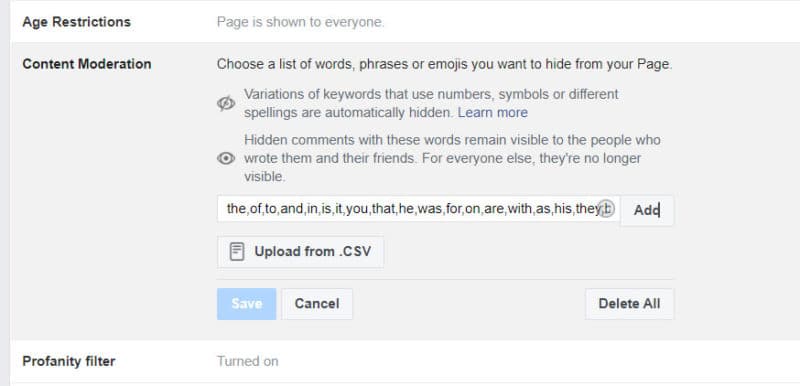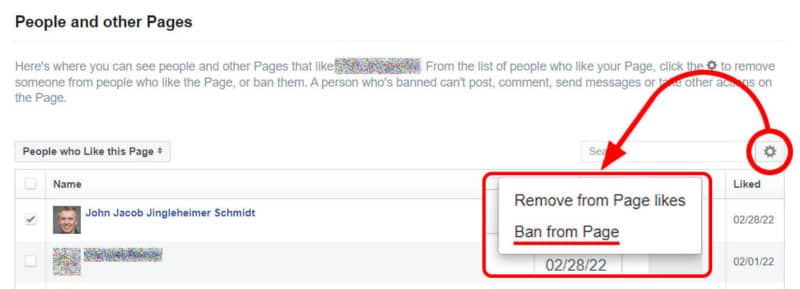
As a reputation consultant, I have handled a full range of public relations issues through Facebook, and if there is one issue that will always be as present as death and taxes, it is negative comments on social media! It is not unusual for organizations — whether they be Fortune 500 companies, mom-and-pop shops, churches, or non-profits — to face negative comments on Facebook. So, I have prepared an updated list of pro tips on how to handle the negativity.
I have written on this topic previously – six years ago I wrote “10 tactics for handling haters on Facebook”, and provided a similar list of tips. However, interfaces at Facebook have changed some since then, and there are more options for one to consider regarding how to manage negativity as effectively as possible.
I remind you that a “light touch” is usually the very best approach to handling negativity on Facebook. When people feel like they are being controlled, “managed,” or that their voice is suppressed, they may escalate to something more extreme and more damaging than a mere negative comment. Sometimes the impulse for smaller companies is to suspend or delete their Facebook Page when confronted with a lot of this negativity.
Let me tell you that this impulse should usually be suppressed. People posting negative comments on social media are seeking respect and acknowledgment, and a Facebook comment can be a pressure release valve that keeps them from escalating into posting negative messages in less manageable arenas like reviews or blog posts. It can also help prevent them from spiraling into credit card chargebacks, attorney general complaints, or even lawsuits.
With that “light touch” philosophy in mind, here is my secret arsenal of tactics for handling negative comments posted on Facebook Pages.
Reply to the comment!
Attempting to diffuse the negativity by responding politely and professionally can sometimes immediately take things down a notch and can be viewed as an overall positive by other consumers who will see the sequence. This is an opportunity to display that you are professional, even in the face of criticism.
Take reasonable criticism seriously, such as responding with some appropriate variation of, “We see your point, and we are going to work to do better.” For customer service issues, try to move the negative interactions out of the public eye by saying something like, “We would like to address this with you directly – please send us an email or call us so that we can discuss the specifics.”
Generally, avoid “returning fire” by matching negativity with negativity. While it may be satisfying to win at one-upmanship or insult an obnoxious person, you are losing the appearance of professionalism with the rest of your audience, and wasting time and resources on things that are not your goals.
Again, if you meet negativity with negativity, you may cause an escalation that will cost much more than a few negative comments. But, if replying is unlikely to work and create an overall positive narrative, proceed to the next tips on this list.
Hide negative comments
Facebook offers one of the best set of social media management tools out there. If you do not want a comment to appear on one of your posts where all can see it, you can click to hide it from view. The Hide control link appears below the post or on the right side if you hover over it, enabling a few different management options that include “Hide”. The brilliant part of this option is that the negative comment will still appear to be visible when the person who posted it views the comments, and also their friends will still be able to see it.
You can also reply to their comment, as per my first tip above, so when you hide their comment, replies to that comment are automatically hidden from everyone else on your Page as well! This can diffuse the anger of the commenter some, as they feel they have accomplished their goal of broadcasting a statement. Short of replying and managing the comment in the public space, this is the best option available. If you are short on time, or your Page receives far too many comments on a daily basis for you to deal with, see the other tips below for further options.

Delete negative comments
Similar to the Hide control, Facebook will allow you to delete comments from your Page entirely. I recommend that you first wait a while for the individual to see that their comment has been visible so they do not keep returning to repost it. Then, click on the three dots beside the comment and select “Delete”.
You will want to use Hide in most cases so that the user does not return and repost, but deleting it may be the best option in some cases, particularly where others have circled in to add their own comments to the original negative one.
Limit the commentators!
Once you have removed a negative comment by hiding or deleting it, you could then limit the commentators on the post so that the critic cannot return and add the negative things all over again.
Once a post is made on a Facebook Page, one may limit the commentators by clicking the three dots in the upper right corner and selecting “Who can comment on your post?” This brings up a menu of options for Public, Pages you follow, and Profiles and Pages you mention. Selecting “Pages you follow” or “Profiles and Pages you mention” will make it so that only those in those groups may comment. This locks out your negative commentator from the post. You could also do this right after posting.
But, there is a negative ramification to limiting the commentators: Facebook uses post interactions, including comments, when determining how many people in your followers list are likely to see the post on their timelines. Once you limit commentators, you are thus sandbagging your promotion efforts to a degree.

Wait. Delete. Repost.
If you just want to scrub the slate clean and start over without the negative baggage, you can always delete your original post, and then post it anew. Doing this will eliminate all the comments.
However, there are significant downsides to this. Just as with the option of limiting the commentators, this de-optimizes the post such that fewer people may see the more recent version.
Facebook displays posts to your followers according to an algorithm that limits or increases visibility based upon a number of factors, including how many people have already interacted with the post. So, a post that already has a number of likes or reactions, comments and shares will lose all those beneficial signals and start over at ground zero. And, you can expect that people who had already interacted with the original post will assume that they do not need to react to, comment on, or share the same post all over again – except for the negative commentator who might return to deface the post with their comment again. So, you might reserve the delete-and-repost tactic for only extreme cases where a post has become some sort of negative, chaotic, feeding frenzy mess.
Set up default moderation for your Page
Businesses have long needed a means for setting all visitors’ comments to be moderated by default so that they can check and approve them, rather than having everything posted to their Pages’ comment section. Thus, it remains surprising to me that there really is not a setting to do this on Facebook.
However, I invented a hack back in 2016 that enables you to do this with the “Content Moderation” settings, which allows you to have a specific set of keywords automatically hidden by default so that you must approve any comments containing those words before your entire audience will see them.
I developed a list of the top most popular English words, which can be added to Facebook’s Content Moderation setting. The words are based on word usage frequency from multiple sources. There are over 1,500 words in this list, and I guarantee they will block 95% to 99.99% of comments from being publicly posted on your Page – and because they will hide most comments, the visitors who post the comments will not realize they are being moderated!
There is already a profanity filter in the Page settings that will keep comments containing strong language from becoming visible just like the Content Moderation tool – you should leave that filter turned on for most Pages. Please note that you will need to review and manually approve all the comments to your Page after implementing this, so it will increase your workload some. If you do not approve comments, you will end up reducing the visibility of your posts in Facebook’s algorithm.
This really should only be used for Pages that have a chronic problem with spam and/or negative and inappropriate comments. Also, be aware that there are some tricky types of comments that will slip through, unmoderated, with this method. (I won’t describe how a few can slip through, since that could give people ideas.)
To use the list, download this CSV and then upload it to your Facebook Page using the Content Moderation setting.

Block the negative commentator from your Page
Does your Page have a constant heckler? This happens at times. If so, you can use the Facebook Page settings to ban them from the Page so they will no longer be able to post comments.
Under the Page’s settings, find the link for “People and other Pages”, click on it, and then search for the user under “People who Like this Page” or “People who follow this Page.” Once you have located them, click the box next to their avatar icon to select them, then click the gear icon button in the upper right of the Page and select “Ban from Page” in the small popup menu. If the heckler is not listed among those who like or follow the Page, click on the box titled “People who Like this Page” that is just above the table listing people who like the Page. Then, select “Ban a person.” Type in the person’s name, select the right person and click to save.
There are some challenges with this option. Highly motivated haters can set up new Facebook accounts under other names, and return to continue heckling the Page. Also, a person will notice they are banned when they try to access the Page, and this may inspire them to post negativity elsewhere in channels that you may not be able to control or influence as easily. So, keep in mind the adage that while you want to keep your friends close to you, you may want to keep your enemies closer!

Hire a third-party moderation service
For organizations that are posting to multiple social media platforms, or that have thousands of followers interacting with their posts, handling all users’ comments, including the negative ones, can be a task requiring round-the-clock management capabilities and a significant time commitment. As I mentioned above, some of the tactics I provide are less desirable because they can impair the promotional reach of posts on Facebook.
If you do not have time to manually review and unhide neutral and positive comments that will get hidden by my keyword content moderation hack, you may want a more dynamic and intelligent option, such as employing a third-party moderation service to handle the review of comments. Using such a service is advisable for big brands, social media influencers, and those with high popularity Pages that have many thousands of followers.
These services can enable your team to more effectively manage comments and provide more robust settings for automation of what to or not to moderate. A number of services provide Facebook comment moderation, so you will need to review them to find one that fits your business case. Three of the top ones from my point of view are Respondology, Smart Moderation (which can work through Hootsuite and Hubspot), and Statusbrew.
Be aware that there are some interface differences between Classic Facebook Pages and their “new Pages experience”, but most of the instructions I provided above are fairly parallel. Facebook also offers a guide to Page moderation, but it does not provide all the nuance and tips that I have outlined above.
Social media remains a difficult beast for many businesses to tame, but hopefully my tips above will help you navigate tactics available to you for handling negative Facebook comments and commentators so that you will have fewer headaches. Stay tuned for an upcoming post on tactics for handling negativity on Twitter!
The post 8 tips on how to handle negative Facebook comments appeared first on MarTech.

0 Comments